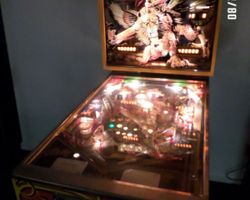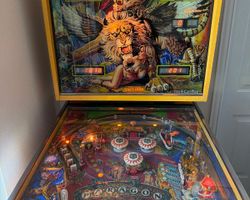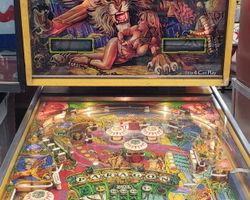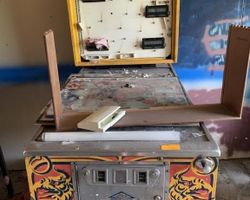Paragon

Average Prices: USD $600 to $2,800
Produced: June, 1979
Production Run: 9,120 units
Machine Type: Solid State Electronic
MPU: Bally MPU AS-2518-35
Players: 4
Design by: Greg Kmiec
Art by: Paul Faris
Paragon, released by Bally Manufacturing Corporation in June 1979, stands as a notable entry in the realm of solid-state electronic pinball. This machine immediately distinguished itself with its fantasy theme, a visual and narrative journey into a mystical world filled with mythical creatures and treacherous landscapes. Its creation was spearheaded by designer Greg Kmiec, a name associated with several engaging Bally titles, while the distinctive visual appeal was crafted by artist Paul Faris.
The design and production of Paragon marked a significant point in Bally's history: it was their inaugural production widebody pinball machine. This expanded playfield format offered a vast canvas, which Faris utilized to depict an elaborate fantasy realm across both the playfield and the backglass. The development process involved a synthesis of tried and true mechanics with innovative concepts. Kmiec incorporated elements from previous designs, drawing inspiration from various successful Bally machines. For instance, the lower flipper arrangement bears a resemblance to Captain Fantastic, while the bottom thumper bumper on the left evokes Old Chicago. The right-side "Knockout Wiggler" channel and its across-the-playfield feed were conceived as an homage to Ted Zale's design philosophy. Furthermore, the in-line drop targets on the left, feeding into a reverse across-the-playfield shot, mirrored the structure seen in Harlem Globetrotters, and the top two saucers shared conceptual similarities with Wizard. An interesting detail from the design phase concerns the "Golden Cliffs" feature; it was anecdotally reported and later confirmed by Kmiec that when this feature was maximized and a ball landed in its saucer, the tune played was an interlude from "The Worm," a song that was on music charts during the machine's development. This musical easter egg continued a tradition, as Bally’s 1978 game Playboy also featured a song tune built note by note. Paragon saw a production run of 9,120 units, establishing itself as a substantial commercial success and a foundational widebody for the manufacturer.
Signature Features and Design
Paragon showcases several elements that define its identity and contribute to its gameplay experience. The most immediate is its widebody cabinet, a design choice that provides a broader, more expansive playfield. This increased real estate allowed artist Paul Faris to create some of the most lauded artwork in pinball history. The fantasy theme permeates every inch, from the intricately detailed backglass depicting a soaring dragon and a mystical realm, to the playfield adorned with fantastical creatures, swirling patterns, and a sense of depth that draws players into its world. The lighting enhances this aesthetic, highlighting key areas and objectives.
Mechanically, Paragon is notable for being the first pinball machine to feature in-line drop targets, specifically the "Valley of Demons" bank of four. This innovation presented a novel challenge, requiring precise shots to clear the targets sequentially. The machine features four flippers in its standard configuration, providing diverse shot angles and control options, particularly with the unique double flipper arrangement on the right side of the playfield. Other standout features include four pop bumpers that create lively rebound action, two slingshots for dynamic ball deflections, three kick-out holes that serve as rewarding targets, two standup targets, four star rollovers for progressive scoring, and a spinning target that adds a dynamic, variable point element. The Beast's Lair, a pop bumper area, and the "waterfall" shot, contribute to a sense of a living, breathing playfield, where the ball’s journey through these distinct zones is integral to the overall experience. The Golden Cliffs saucer, with its unique auditory reward, further solidifies the machine's distinctive character.
Playfield and Mechanics
The playfield of Paragon is a sprawling landscape of challenges and opportunities, thoughtfully laid out within its widebody dimensions. At the bottom, the four flippers provide players with a range of shot possibilities. The left side features a bank of four in-line drop targets, known as the "Valley of Demons," which are a primary objective. These targets are strategically placed to feed into a unique reverse across-the-playfield shot when cleared. Above these, a kick-out hole offers a rewarding target. The lower left also includes a pop bumper and a slingshot, contributing to the chaotic yet controlled movement of the ball.
Moving upwards, the playfield opens into various pathways and features. The central area includes a bank of three drop targets and a spinning target, both offering score multipliers and progression. Three kick-out holes are strategically positioned across the playfield, demanding accurate shots for lucrative points and ball returns. The upper right side of the playfield is particularly distinct, featuring an upper right flipper (in the standard four-flipper version) and a "chicane lane" that, when utilized, awards lit features. This area also houses the Beast's Lair, a zone dominated by a pop bumper, which can send the ball wildly around, adding an element of unpredictability. The "Golden Cliffs" saucer, a high-value target, is also located in the upper playfield. Paul Faris's artwork on the playfield integrates seamlessly with these mechanical elements, with intricate details depicting mythical creatures, ancient structures, and a vibrant color palette that enhances the depth and visual appeal of the wide expanse. The lighting system complements the artwork, drawing attention to active targets and scored features, guiding the player's eye across the expansive field.
Gameplay Dynamics
Gameplay on Paragon is characterized by its challenging nature and rewarding progression. The scoring system encourages players to pursue various objectives, balancing direct target hits with more complex sequences. A primary objective involves clearing the "Valley of Demons" in-line drop targets; each successful hit advances the player towards a significant point bonus and potentially unlocks other features. The three-bank drop targets also offer strategic scoring opportunities. Utilizing the three kick-out holes across the playfield is crucial for maximizing scores, as they often lead to high-value awards or beneficial ball returns.
Paragon distinguishes itself with several unique challenges. The multiple flippers demand adaptability, especially the double flipper setup on the right, which can be both an asset for unique shot angles and a potential hazard for unexpected drains. The upper right chicane lane requires a precise shot to activate lit features, adding a layer of strategic thinking. The "Golden Cliffs" saucer presents a progressive objective, where repeated successful shots build a musical tune, rewarding persistence. The pop bumpers in the Beast's Lair contribute to the frenetic pace, making ball control a significant skill to master. Strategies often involve carefully managing the ball on the flippers to set up precise shots at the in-line targets, learning the angles to consistently hit the kick-out holes, and skillfully navigating the upper playfield to accumulate lit feature bonuses. The difficulty of the machine encourages players to refine their ball control and shot accuracy, making each successful sequence feel earned and highly satisfying.
Reception and Legacy
Paragon has garnered an overwhelmingly positive reception within the pinball community since its release. Its strengths are frequently highlighted, beginning with its artwork. Paul Faris's fantasy visuals, particularly the backglass and playfield art, are consistently praised as some of the most captivating and detailed in the history of pinball, immersing players in its thematic world. The gameplay is widely described as challenging, addictive, and ultimately rewarding. Players appreciate the variety of shots available, the innovative in-line drop targets, and the fluid flow of the playfield that encourages deep engagement. Many enthusiasts consider it an excellent machine for honing ball control skills due to its demanding nature. The unique features, such as the active Beast's Lair pop bumper area, the "waterfall" shot, and the distinct double flippers on the right, contribute to its individuality. Paragon's replayability is a common point of acclaim, with many players feeling compelled to play "one more game" in pursuit of higher scores or mastery. Historically, it is recognized as a significant classic and a milestone in pinball design. Despite its robust feature set and aesthetic appeal, some in the community have historically viewed it as "underpriced" compared to other machines of its caliber.
While largely celebrated, Paragon is not without its noted points of contention. The sound quality is often mentioned as a weakness, typical of its era with primarily beeps and boops rather than more complex audio tracks. The machine's inherent difficulty can be unforgiving, potentially deterring less experienced players who might find its challenging shots and draining tendencies frustrating. While the widebody design is a defining feature, some players simply prefer standard-body machines and find widebodies less dynamic. Specifically, the gap between the double flippers on the right side of the playfield is often cited as a challenging area prone to unexpected drains.
Despite these minor criticisms, the overall sentiment towards Paragon remains exceptionally positive. It is firmly established as a classic, frequently cited as a must-play for pinball enthusiasts, and admired for its visual artistry. Its legacy is cemented by several key contributions to pinball history. As Bally's first widebody production game, it set a precedent and demonstrated the potential for expanded playfield designs, influencing future widebody developments in the industry. More notably, Paragon introduced the concept of in-line drop targets, a feature that would later be adopted and evolved in subsequent pinball machines. The variations produced for the European market, specifically the three-flipper versions that incorporated the "Italian Bottom" design, also showcased Bally's responsiveness to specific market preferences and contributed to the evolution of playfield layouts in the industry.
Sponsored Links
 Ebay Listings
Ebay Listings
 Auction Results
Auction Results
| Cost | Location | Date |
|---|---|---|
| USD $3,000 |  Illinois, United States Illinois, United States |
06 November, 2025 |
| USD $175 |  Texas, United States Texas, United States |
19 October, 2025 |
| USD $3,800 |  California, United States California, United States |
04 June, 2025 |
| USD $3,500 |  Florida, United States Florida, United States |
13 May, 2025 |
| USD $2,700 |  Maryland, United States Maryland, United States |
31 March, 2025 |
| USD $2,600 |  California, United States California, United States |
27 March, 2025 |
| USD $1,500 |  Florida, United States Florida, United States |
09 August, 2024 |
| USD $1,550 |  Georgia, United States Georgia, United States |
01 May, 2024 |
| USD $2,200 |  North Carolina, United States North Carolina, United States |
25 April, 2024 |
| USD $1,725 |  Indiana, United States Indiana, United States |
23 April, 2024 |


Private Policy · Search Website · Contact Us
As an eBay Partner, we may earn a commission from qualifying purchases made through links on this site, at no additional cost to you.
All trademarks and copyrighted materials remain property of their respective owners. All other content copyright 2007 - 2025 Pinpedia.







